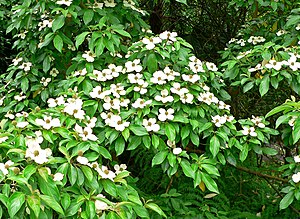Bentham's dogwood
| Bentham's dogwood | ||||||||||||
|---|---|---|---|---|---|---|---|---|---|---|---|---|

Branch of Bentham's dogwood ( Cornus capitata ) with numerous inflorescences |
||||||||||||
| Systematics | ||||||||||||
|
||||||||||||
| Scientific name | ||||||||||||
| Cornus capitata | ||||||||||||
| Wall. ex Roxb. |
Bentham's dogwood ( Cornus capitata ) is a species of the dogwood ( Cornus ) genus . It is a small, evergreen tree that is found in the eastern Himalayas , hence the name Himalayan dogwood , which is sometimes used .
The botanical name is derived from the Latin caput - head, many flowers are united to form an inflorescence , a little head .
Bentham's dogwood is sometimes listed together with some related species as the genus Dendrobenthamia , which translates as "Bentham's tree". Like the German name, this refers to the botanist George Bentham .
description
Bentham's dogwood is a small, evergreen tree . The largest specimens reach a height of up to fifteen meters, but multi-stemmed shrubs can also remain. The crown is spread out, older specimens are often wider than high. The young twigs are gray, they turn dark brown to gray-brown over time and form a slightly cracked or flaky bark on thick trunks.
The opposite , oval leaves are dull gray-green and covered with tight hairs on the underside, so that they feel rough. The leaf veins , usually only three or four pairs, are curved towards the tip of the leaf, as in many dogwoods. A small part of the leaves fall in autumn, but most of them stay on until spring. When the new leaves unfold, last year's ones turn yellow and fall off, this behavior is called "wintergreen".
The inflorescence consists of fifty to a hundred tiny individual flowers, which are grouped together in a spherical umbel . The bracts that surround the inflorescence are noticeable : they are laid out in autumn and are visible on the flower buds, then develop from light green to creamy white and fade with a touch of pink. The flowering time is in early summer, in Yunnan from about May to July.
All fruits of an inflorescence develop into a fruit cluster with many pips and a leathery skin. This is round and red in color, about three centimeters in diameter. It is somewhat reminiscent of strawberries in size and color and is edible.
The number of chromosomes is 2n = 22.
distribution
From Nepal through India and Myanmar to the People's Republic of China , the species colonizes the eastern Himalayas at altitudes between 800 and 3200 meters. It grows there on the edge of coniferous and deciduous forests in a summer-humid climate without severe frosts.
use
Bentham's dogwood is sometimes grown as an ornamental shrub. Good varieties with their reddish-colored shoots in spring, the long-lasting bracts that change from creamy white to pink in summer, striking red fruits in autumn and partly yellow or reddish colored, partly green leaves in winter are an eye-catcher in every season of the year. However, it does not endure severe frosts or dry heat, so that its distribution as an ornamental plant is not very widespread.
Some breeders are trying to find more frost-resistant varieties or use the species for crossings: Cornus 'Porlock' and Cornus 'Norman Hadden' are two hybrids with the deciduous Cornus kousa , here some of the leaves turn red in autumn and fall off, some remain Adhere to spring.
Individual evidence
- ↑ Guan Kaiyun (Ed.): Highland Flowers of Yunnan. Yunnan Science and Technology Press, 1998, ISBN 7-5416-1123-9 .
- ^ Bentham's Dogwood in the Flora of China
- ↑ Cornus capitata at Tropicos.org. In: IPCN Chromosome Reports . Missouri Botanical Garden, St. Louis
- ↑ J. Hillier, J. Kelly (Ed.): Trees and bushes. Thalacker, Braunschweig 1997, ISBN 3-87815-086-5 , p. 240.
